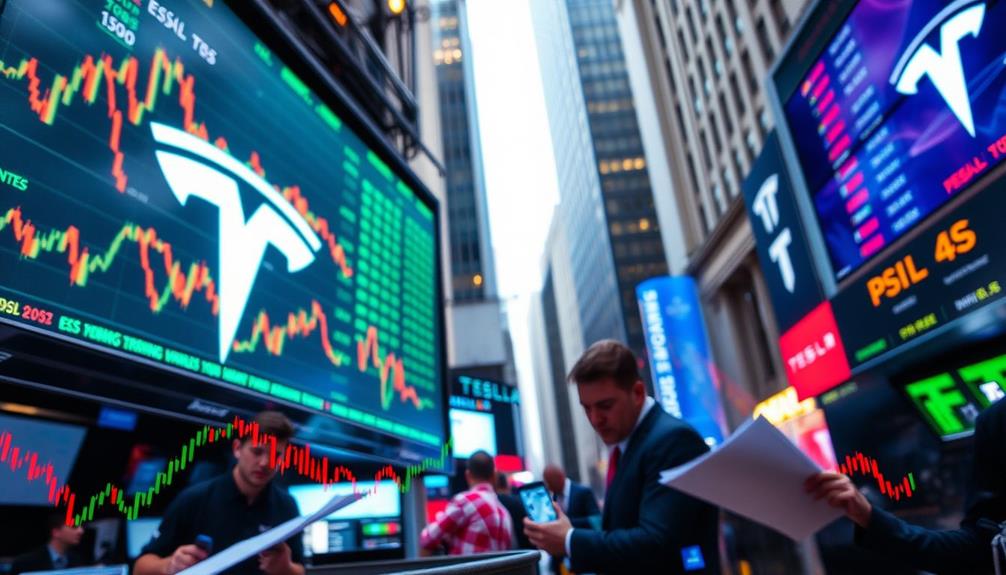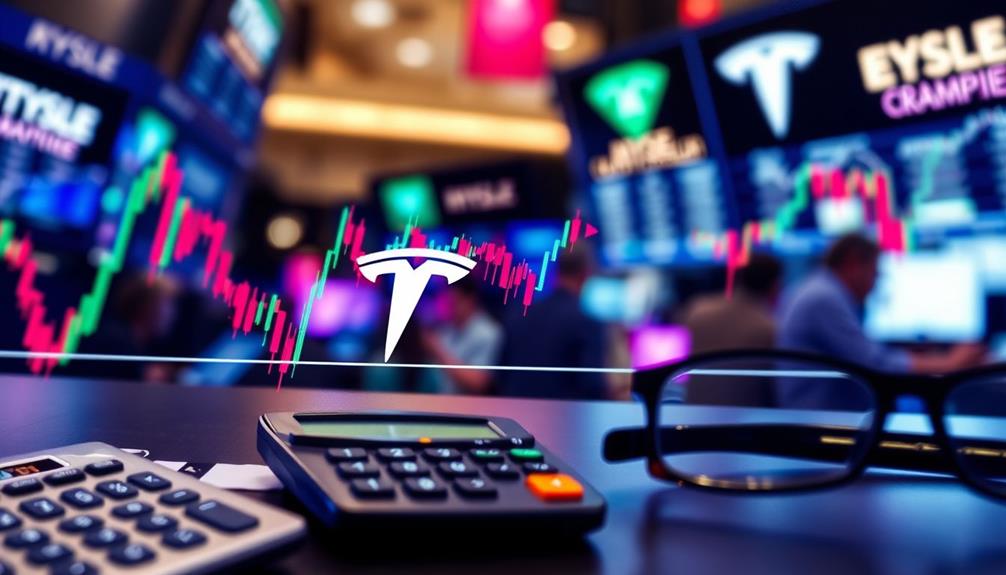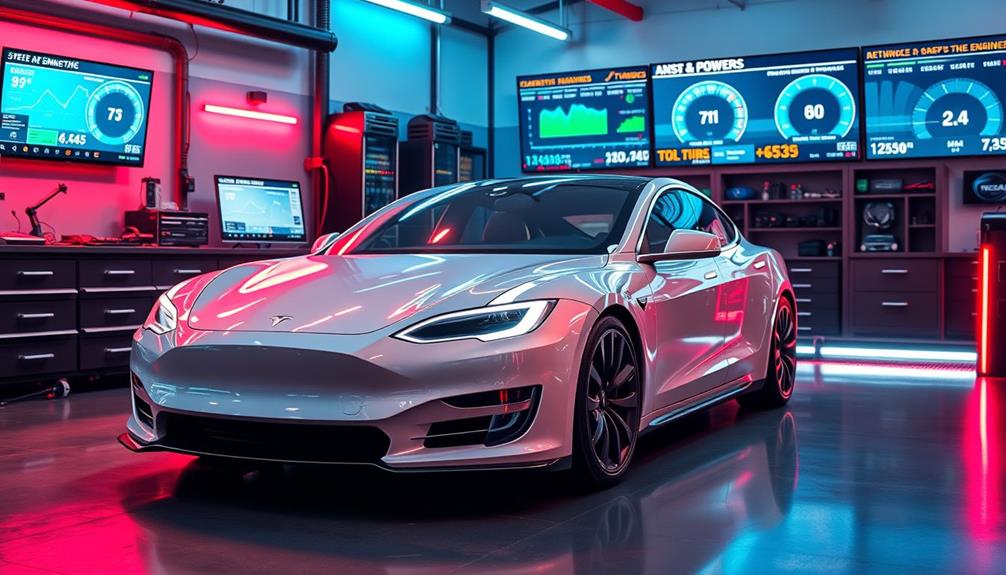If you're considering Tesla stock, it's wise to weigh its recent performance against the market backdrop. The stock recently increased 4.18%, but it's still down 12% year-to-date. Analysts predict a decline in earnings per share for 2024, raising caution. However, developments like the upcoming robotaxi reveal could greatly shift investor sentiment. With ambitious production goals for a more affordable model in 2025, there's potential for growth. Morgan Stanley even sees a 40% upside if risks are managed well. By keeping an eye on these factors, you'll gain valuable insights into Tesla's evolving landscape.
Key Takeaways
- Tesla's stock has rebounded 60% from late-April lows, but remains down 12% year-to-date, indicating volatility.
- Upcoming Robotaxi announcement on October 10 could significantly influence stock perception and investor confidence.
- Anticipated mass production of an affordable vehicle in 2025 could expand market reach, though cancellation rumors persist.
- Regulatory challenges, including tariffs and safety investigations, may impact operational costs and pricing strategies.
- Analysts predict a 28% decline in EPS for 2024, which could affect investor sentiment and stock valuation.
Current Stock Performance

When you look at Tesla's current stock performance, you'll notice a mix of volatility and resilience. As of September 4, 2024, the stock price sits at $219.41, reflecting a 4.18% increase from the previous day and a remarkable 60% recovery from late-April lows.
However, don't overlook the year-to-date decline of 12% and a 20% drop since July 2024 highs, which highlight the volatility in investor sentiment.
Tesla's market capitalization is about $700.936 billion, with a 52-week high of $278.97 and a low of $138.80, indicating substantial interest from investors despite the fluctuations.
Analysts project an earnings per share (EPS) of $2.24 for 2024, down 28% from the $3.12 EPS reported in 2023, which may raise concerns about future profitability.
With a Composite Rating of 67, Tesla ranks third in the IBD Auto Manufacturers industry group, showing mixed performance relative to its peers.
Given these factors, you might be wondering if now's a smart time to buy. Balancing the stock's resilience against its volatility will be key in making your investment decision.
Robotaxi Developments

Tesla's highly anticipated Robotaxi disclosure, originally set for August 8, 2024, has been rescheduled for October 10, 2024, as the company aims to incorporate critical design improvements.
Elon Musk's commitment of $10 billion to AI training and infrastructure this year aims to elevate Tesla's ride-hailing services and enhance autonomy. This investment reflects a strong belief in the robotaxi's potential, which Ark Invest projects will account for 90% of Tesla's enterprise value by 2029, with a price target soaring to $2,600 per share.
However, if the robotaxi network fails to deliver, that target could plummet to $350.
Investor sentiment remains optimistic about the launch of the robotaxi service within the next five years, further boosting confidence in Tesla stock.
The upcoming disclosure is expected to notably influence earnings and stock performance, as the market closely watches advancements in autonomous technology.
As you consider your investment strategy, keep an eye on these developments, as they could reshape the future of Tesla and its vehicle design, driving the stock's trajectory in the coming years.
Future Vehicle Production

The future of vehicle production at Tesla hinges on strategic decisions that could shape its market presence. As you look ahead, keep an eye on the anticipated mass production of an affordable vehicle, previously known as the Model 2, slated for the first half of 2025. However, there's speculation it might be scrapped, which could impact Tesla's stock price target.
In 2024, vehicle volume growth is projected to slow, with Q3 delivery estimates at 458,000 units—a modest 5% year-over-year increase. To counter this, Tesla is ramping up production capacity and efficiency.
New models, including upgraded versions of the Model Y and the highly anticipated Cybertruck, are set to stimulate demand and help maintain Tesla's competitive edge in the electric vehicle sector.
Moreover, Tesla's energy storage business is expected to grow faster than its automotive segment, emphasizing diversification in production efforts.
With increasing competition in the market, the introduction of these new models and strategic production initiatives is essential for Tesla to solidify its position and appeal to a broader audience. Keeping an eye on these developments will be key to understanding Tesla's future trajectory.
Regulatory Challenges

Maneuvering regulatory challenges is essential for Tesla as it seeks to maintain its competitive edge in the evolving electric vehicle market. The company faces an additional 9% tariff imposed by the European Union on vehicles imported from China, a figure that's lower than the anticipated 21% for other Chinese EV manufacturers.
However, the existing 10% tariff on all foreign-made cars in the EU still impacts Tesla's pricing strategy and competitiveness.
Additionally, ongoing investigations into faulty suspension and steering components have highlighted issues affecting specific models in Norway and Sweden, posing further challenges.
The National Highway Traffic Safety Administration (NHTSA) has also recalled over 2 million Tesla vehicles due to concerns regarding Autopilot misuse, prompting new investigations regarding the adequacy of over-the-air updates.
These instances of regulatory scrutiny can considerably affect Tesla's operational costs and market positioning.
To thrive in this complex landscape, Tesla must adapt its production and sales strategies effectively.
Market Position and Analyst Views

Maneuvering the current market landscape, Tesla finds itself in an intriguing position among competitors. Currently ranking third in the IBD Auto Manufacturers industry group, it holds a Composite Rating of 67 amid a challenging market environment. Analysts have mixed views, particularly with a projected decline in earnings per share for 2024, estimating $2.24—a 28% decrease from $3.12 in 2023. This reflects concerns about Tesla's future growth.
Despite the volatility, TSLA stock has rebounded 60% from late-April lows, even with a 12% drop year-to-date and a 20% decrease since July 2024 highs.
Morgan Stanley remains optimistic, naming Tesla as its top pick in the U.S. auto sector, projecting a 40% upside potential due to effective risk management and innovation. Ark Invest also sees long-term value, forecasting a price target of $2,600 by 2029, heavily reliant on the success of the forthcoming robotaxi initiative.
In this context, Tesla's position in the market remains both precarious and promising, depending on how it navigates upcoming challenges and capitalizes on its innovations.
Investment Considerations

Investors should carefully weigh Tesla's current stock performance against its potential for future growth. The stock has dropped about 12% year-to-date and 20% since its July highs, raising concerns about its valuation. Analysts predict a 28% decline in earnings per share for 2024, estimating them at $2.24 versus $3.12 in 2023. This decline could dampen investor confidence, prompting some to reconsider whether now's the time to buy.
However, the upcoming revelation of the Robotaxi on October 10, 2024, could shift market perceptions and provide a catalyst for stock recovery. Morgan Stanley still identifies Tesla as a top U.S. auto pick, projecting a remarkable 40% upside for TSLA, which suggests strong long-term potential despite recent volatility.
Additionally, the anticipated production of an affordable vehicle in early 2025 could enhance Tesla's market reach, although concerns over the possible cancellation of the $25,000 Model 2 vehicle could impact future growth strategies.
Ultimately, weighing these factors is significant for investors seeking to navigate the complexities of Tesla's stock and its potential within the broader market context.
Frequently Asked Questions
Is Tesla Stock a Good Buy Right Now?
You should consider Tesla's current stock situation cautiously. With projected earnings declines and regulatory challenges, weigh the potential risks against the anticipated growth from the Robotaxi and affordable vehicle production before making a decision.
How Much Will Tesla Stock Be in 5 Years?
In five years, Tesla's trajectory teeters on transformative technology. If the robotaxi rolls out successfully, you might see soaring stock prices. But without it, you could face disappointing declines, possibly plunging to $350.
What Is the Stock Market Prediction for Tesla in 2025?
In 2025, you can expect Tesla's stock to benefit from increased production, new affordable models, and growth in its energy segment. Analysts predict significant earnings and sales momentum, potentially boosting its market value substantially.
What Is the Price Target for Tesla?
Tesla's price target varies markedly based on future developments. Ark Invest projects $2,600 by 2029, heavily relying on the robotaxi initiative, while without it, estimates drop to around $350 per share. It's essential to contemplate both scenarios.
Conclusion
In today's volatile market, Tesla stock might just be the golden ticket you're searching for. With exciting robotaxi developments and ambitious future vehicle production on the horizon, the company is steering toward growth. However, keep an eye on regulatory challenges that could throw a wrench in the works. Ultimately, weighing expert opinions and your own investment goals will help you decide if diving into Tesla is the right move for you.










